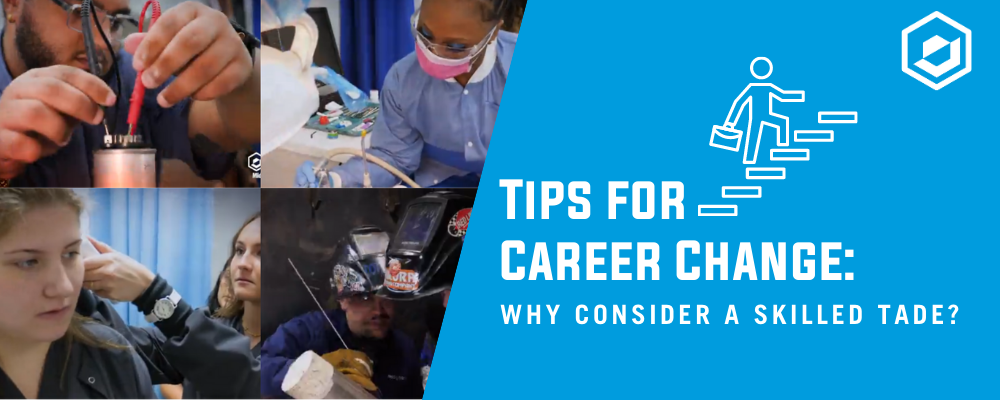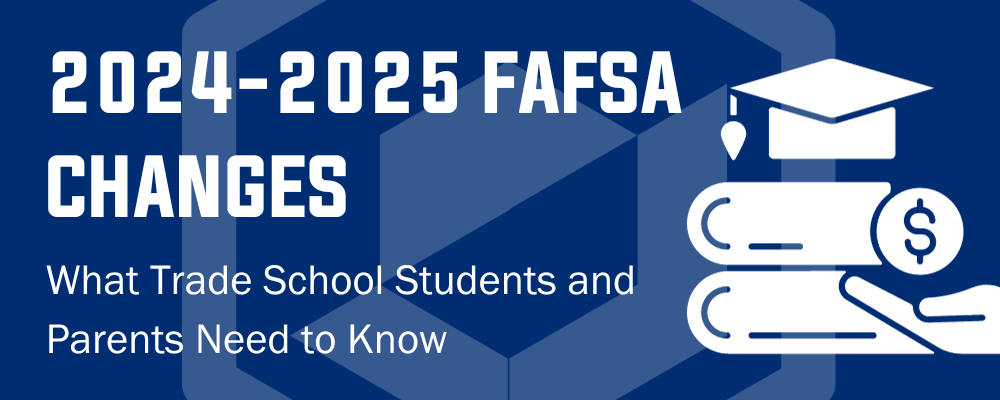Are you looking for career change advice? Learning how to change your career path can be overwhelming, but it’s more common to switch paths than you might think. According to the U.S. Bureau of Labor Statistics, baby boomers held 12 jobs on average between ages 18-54.
Today, the United States is facing a labor shortage, meaning there are more open jobs than workers available to fill them. According to a 2021 report on Skilled Trades in America, the median age of skilled trades workers is 43—and with fewer younger people entering the field every year, coupled with the wave of baby boomers retiring, the gap is expected to grow.
However, there are plenty of great reasons to consider learning a skilled trade—such as earning potential, less student loan debt compared to a 2-year or 4-year degree, available positions within the field, a wide variety of career trajectories, and even entrepreneurial opportunities.
MTI has helped thousands of students launch careers in industries that can offer competitive pay, such as mechanical trades, allied health, and truck driving. If you want to learn how to change your career path by learning a skilled trade, this article provides some helpful information.
Why Change Careers? Signs You’re Ready to Move On
If you’re looking for career change advice, you’ve likely already experienced the signs that it’s time to move on from your current situation. It’s important to recognize these common signs.
- You Don’t Find Your Work Interesting
Does your current work spark your interest? Are you continuously learning, growing, and improving? If not, you may end up feeling disengaged with your professional responsibilities. You don’t necessarily need to love what you do, but it can help mitigate stress if you’re at least interested in what you do.
- You Have No Work/Life Balance
“Job burnout” is described as a condition in which work-related stress leads to a state of physical and mental exhaustion. Left untreated, job burnout can make you more susceptible to developing insomnia, depression, high blood pressure, heart disease, and other complications. If you’re experiencing a lack of control in your work, if you work in a dysfunctional setting, or if you have minimal work/life balance, you may be at risk for burnout.
- Your Opportunities for Growth Are Limited
Do you feel stunted in your current position? If you feel like your work is unappreciated or if your company/industry offers little room for advancement, this can contribute to “job burnout”. The longer you’re exposed to these factors, the greater potential you will desire to change careers.
How to Decide on a Career Change: The Key Benefits
There are many motivating factors which prompt people to explore career options again. Here are some of the most common reasons attributed to career change:
- Seeking more competitive wages
- Realigning skills to growing/in-demand industries
- Improved work/life balance
- Greater autonomy and work flexibility
- Changing goals and priorities
- Better job security
- Opportunities for growth
Keep in mind, there are pros and cons associated with every career. For example, you may find some employment opportunities offer more interesting job responsibilities, but you may need to compromise on your level of pay. Ultimately, the “best” career change advice is that which supports your professional goals and overall well being.
Interested in Learning More About MTI?
Fill out the form below to receive info about our career training programs.
Career Change Tips
Ready to take the first step toward a new career? Here are some tips for career change to get you started:
- Choose The Right Career For You
At MTI, our goal is to help you find a career path that includes doing something you are truly passionate about. If you need some inspiration to help guide your search, consider taking a career quiz to help you better understand what sorts of careers might best suit your personality and preferences.
- Create an Action Plan
After you explore career options and choose a new path to move forward, it’s time to create an action plan. In many cases, a career change requires additional skills training, such as vocational training at a trade school. It’s important to create a plan and timeline, for example, at MTI our Admissions Representatives help you find a program that aligns with your goals, choose a class schedule that works for your lifestyle, and understand your financial aid options.
Why Consider a Skilled Trade?
- Opportunity for High Wages
For many students in high school, the general advice is to attend a traditional college in pursuit of a bachelor’s degree. In reality, recent skilled trade news indicates thousands of high-paying jobs are currently available without a college degree. According to the same report from NPR, a shortage of workers in the skilled trades is pushing wages higher, while the financial return from a bachelor’s degree continues to soften.
- Less Student Loan Debt and Less Time in School
Students who attend traditional 4-year college may be saddled with student debt. In comparison, training programs for skilled trades, such as welding, medical assisting, dental assisting, and HVAC/R, cost thousands of dollars less than a 4-year degree.
Compared to a traditional university, another key benefit to trade school compared to 4-year college is it can be completed in a fraction of the time. At MTI, most programs can be completed in less than a year. For example, you can train to become a medical assistant in just 9 months and start your new career. Similarly, you can train to become a welder and pipefitter in just 10 months and earn certifications that will help you pursue professional opportunities in the field.
- More Opportunities for Flexibility, Travel, and Variety
Trade school is a great option if you enjoy working in a hands-on environment and solving problems. In addition, some careers within the skilled trade sector can offer opportunities for travel. For example, skilled welders are sought for a wide variety of infrastructure projects throughout the world. Professional truck drivers are another example as they frequently drive routes that take them all across state lines.
What Skilled Trades Are in Demand?
Many of the skilled trade programs MTI offers are in demand as of 2023. Check out these recent figures provided by the U.S. Bureau of Labor Statistics (BLS):
Demand for Dental Assistants
- Dental Assisting — 8% growth and 388,700 total projected jobs through 2031
The link between oral health and general health is assumed to keep this skilled trade in demand over the next decade. According to recent BLS figures, roughly 56,400 openings for dental assistants are anticipated each year, on average, over the decade. You can train to become a dental assistant in just 9 months with MTI.
Demand for HVAC/R Technicians
- HVAC/R — 5% growth and 414,400 total projected jobs through 2031
The demand for HVAC/R technicians is primarily tied to the continued growth of commercial and residential building construction. According to recent BLS figures, approximately 40,100 professional opportunities for heating, air conditioning, and refrigeration mechanics and installers are anticipated each year, on average, over the decade. You can train to become an HVAC/R technician in just 9 months.
Demand for Medical Assistants
- Medical Assisting — 16% growth and 861,300 total projected jobs through 2031
As the baby-boom population continues to age, the demand for medical assistants continues to significantly outpace the average percent of growth for all occupations (5%). According to recent BLS figures, around 123,000 openings for medical assistants are anticipated each year, on average, over the decade. You can train to become a medical assistant in just 9 months with MTI.
Demand for Skilled Welders & Pipefitters
- Welding — 2% growth and 434,900 total projected jobs through 2031
- Pipefitting — 2% growth and 486,000 total projected jobs through 2031
The demand for skilled welders and pipefitters is largely tied to aging national infrastructure, including various bridges, highways, and buildings. According to recent BLS figures, approximately 47,600 openings for welders, cutters, solderers, and brazers are anticipated each year, on average, over the decade. You can train to become a welder in just 7 months or train to become a welder and pipefitter in just 10 months with welding & pipefitting training.
Explore Your Career Options at MTI
Ready to explore your career options in the skilled trades? Fill out the form to connect with an MTI Admissions Representative and learn more about our hands-on training programs!



